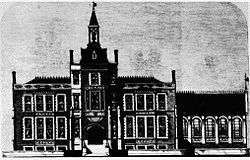Leicester Stanhope, 5th Earl of Harrington
Leicester FitzGerald Charles Stanhope, 5th Earl of Harrington CB (2 September 1784 – 7 September 1862),[1] styled The Honourable Leicester Stanhope until 1851, was an English peer and soldier.
Early life
Leicester Stanhope was born in Dublin in 1784, the third son of Charles Stanhope, 3rd Earl of Harrington, and Jane Stanhope, Countess of Harrington.
Career
Stanhope became a Cornet and Sublieutenant in the 1st Regiment of Life Guards on 1 October 1799.[2] He was promoted lieutenant on 20 October 1802.[1] He exchanged into the 9th Regiment of Foot on 19 March 1803,[3] and on 2 April 1803 purchased a captaincy in the 10th (Prince of Wales's Own) Regiment of (Light) Dragoons.[4] On 9 November 1803, he exchanged into the Carabiniers (6th Dragoon Guards),[5] and on 27 January 1813, into the 17th Regiment of Light Dragoons.[6] Promoted major, he was appointed Deputy Adjutant-General in the East Indies on 29 June 1815, as a brevet lieutenant-colonel.[7] He exchanged into the 47th Regiment of Foot while serving there and was appointed Deputy Quartermaster-General on 24 April 1817.[8]
From late 1817 to 1818, Stanhope and his regiment took part in the Third Anglo-Maratha War. On 14 October 1818, he was appointed a Companion of the Bath for his service in the conflict.[9] He resigned as quartermaster on 29 March 1821[10] and purchased an unattached lieutenant-colonelcy on 26 June 1823.[11] He was brevetted colonel on 10 January 1837.[12]
Personal life and death
On 23 April 1831, at St James's Church, Piccadilly, he married Elizabeth Green, daughter of William Green[1] and Ann Rose Hall, both of Jamaica. They had four children:
- Lady Anna Caroline Stanhope (16 July 1832 – 9 April 1913), married Edward Sacheverell Chandos-Pole and had issue
- Algernon Russell Gayleard Stanhope (1838–1847)
- Lady Geraldine Evelyn Stanhope (26 January 1841 – 5 January 1914), married Edward Leeson, 6th Earl of Milltown, without issue
- Sydney Stanhope, 6th Earl of Harrington (1845–1866)
In 1851, he inherited the earldom from his brother, Charles Stanhope, 4th Earl of Harrington.

In 1852 Stanhope acquired a plot of land formerly belonging to the kitchen garden of Kensington Palace: he constructed Harrington House (or No. 13 Kensington Palace Gardens), which was built in his favourite gothic style, at the cost of £15,000.[13] Harrington House was owned by the family until the First World War; Since 1930 Harrington House has been home to the Russian Embassy.[13] The exterior of the house was designed by Decimus Burton, following plans sketched by the Earl.[14] Works were carried under the supervision of C.J. Richardson, who was the surveyor to the Earl's vast South Kensington estate.[14] Details and the final plans are thought to have been left to Richardson; he did, however, acknowledge the "great measure" the Earl was involved in the design.[14] The house's unorthodox architecture was widely criticised, including by Richardson; Lord Harrington, however, thought it to be "a house without a fault".[14]
Stanhope died 7 September 1862, at Harrington House.[15]
He was succeeded by his son: Sydney Seymour Hyde Stanhope, 6th Earl of Harrington
Styles of address
- 1784-1818: The Hon Leicester FitzGerald Charles Stanhope
- 1818-1851: The Hon Leicester FitzGerald Charles Stanhope CB
- 1851-1862: The Rt Hon The Earl of Harrington CB
References
- 1 2 3 Doyle, James William Edmund (1886). The Official Baronage of England, v. 2. London: Longmans, Green. p. 136.
- ↑ The London Gazette: no. 15188. p. 995. 28 September 1799.
- ↑ The London Gazette: no. 15567. pp. 287–288. 15 March 1803.
- ↑ The London Gazette: no. 15571. p. 369. 29 March 1803.
- ↑ The London Gazette: no. 15641. p. 1545. 8 November 1803.
- ↑ The London Gazette: no. 16697. p. 186. 23 January 1813.
- ↑ The London Gazette: no. 17037. p. 1355. 8 July 1815.
- ↑ The London Gazette: no. 17248. p. 1087. 6 May 1817.
- ↑ The London Gazette: no. 17409. p. 1851. 18 October 1818.
- ↑ The London Gazette: no. 17695. p. 782. 7 April 1821.
- ↑ The London Gazette: no. 17937. p. 1090. 5 July 1823.
- ↑ The London Gazette: no. 19456. p. 65. 10 January 1837.
- 1 2 "NO.13 KENSINGTON PALACE GARDENS: HARRINGTON HOUSE". Russian Embassy. Retrieved 17 April 2013.
- 1 2 3 4 Sheppard (ed.), F. H. W. (1973). Survey of London: volume 37: Northern Kensington: The Crown estate in Kensington Palace Gardens: Individual buildings. pp. 162–193.
- ↑ Leslie, Sir Stephen (1885). Dictionary of national biography: Volume 54.
External links
- Hansard 1803–2005: contributions in Parliament by the Earl of Harrington
 Lee, Sidney, ed. (1898). "Stanhope, Leicester Fitzgerald Charles". Dictionary of National Biography. 54. London: Smith, Elder & Co.
Lee, Sidney, ed. (1898). "Stanhope, Leicester Fitzgerald Charles". Dictionary of National Biography. 54. London: Smith, Elder & Co. - Portrait of the 5th Earl, by Sir Joshua Reynolds.
| Peerage of Great Britain | ||
|---|---|---|
| Preceded by Charles Stanhope |
Earl of Harrington 1851–1862 |
Succeeded by Sydney Seymour Hyde Stanhope |